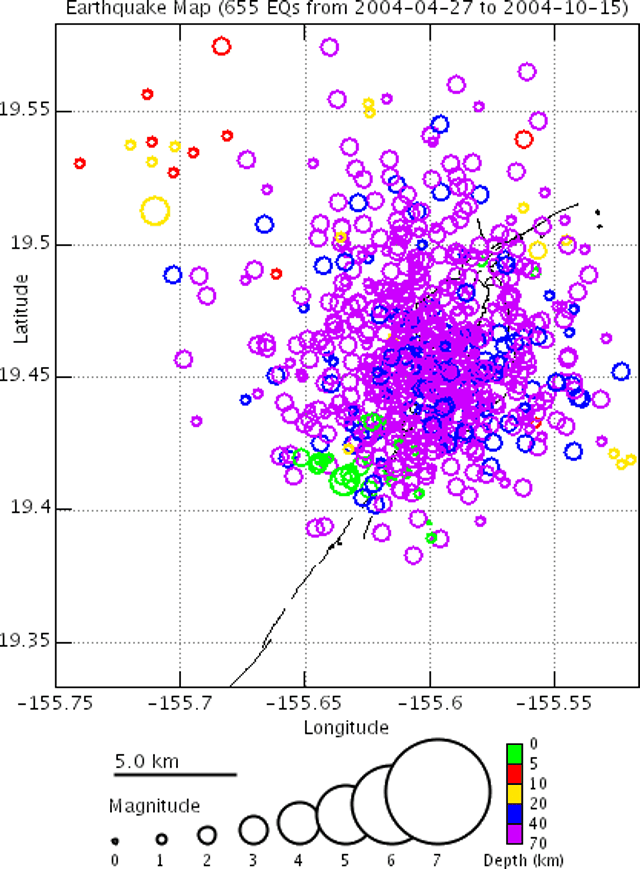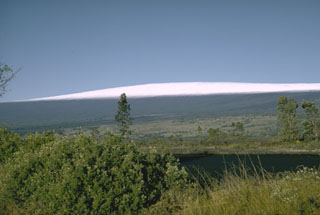Report on Mauna Loa (United States) — September 2004
Bulletin of the Global Volcanism Network, vol. 29, no. 9 (September 2004)
Managing Editor: Richard Wunderman.
Mauna Loa (United States) Deep, long-period earthquake swarm and contraction in July and August 2004
Please cite this report as:
Global Volcanism Program, 2004. Report on Mauna Loa (United States) (Wunderman, R., ed.). Bulletin of the Global Volcanism Network, 29:9. Smithsonian Institution. https://doi.org/10.5479/si.GVP.BGVN200409-332020
Mauna Loa
United States
19.475°N, 155.608°W; summit elev. 4170 m
All times are local (unless otherwise noted)
After a swarm of deep earthquakes centered just S of Mauna Loa's summit caldera in late April 2002, seismicity remained barely elevated until July 2004. In other words, seismicity during late April 2002-July 2004 stood far lower than it did in the months prior to the 1975 and 1984 eruptions.
Starting in July 2004, a swarm of small (M < 3), deep (> 40 km), mostly long-period (LP) earthquakes occurred just S of the caldera and adjacent areas. Neither the depth nor the magnitude of the earthquakes changed significantly. Through 13 October 2004 more than 730 related earthquakes occurred beneath the summit caldera and the adjacent part of the SW rift zone.
The location and magnitude of earthquakes making up the recent swarm (seismicity from 24 April-15 October 2004, a 6-month interval) are shown in figure 23. Such a concentration of deep LP earthquakes from this part of Mauna Loa was unprecedented in the modern earthquake record dating back to the 1960s. In contrast, more typical seismicity over a 6-month period at Mauna Loa is shown in a figure in a previous issue (BGVN 27:09). By comparison to the interval 24 April-15 October 2004, earthquakes in a typical 6 month interval are relatively sparse.
 |
Figure 23. Seismicity for Mauna Loa for the 6-month period 24 April-15 October 2004. Courtesy of the U.S. Geological Survey, Hawaiian Volcano Observatory. |
Inflation continued at the summit through the start of the earthquake swarm. In late August 2004, however, distances across the summit caldera began to contract significantly, apparently caused by the center of inflation shifting slightly to the S, rather than by deflation. This was the first contraction since inflation started in late April or early May 2002. Toward the end of September, the contraction ended and the line once again began to lengthen. During 2004, the inflation had been at a fairly steady to slightly increasing rate until the contraction in late August. When present, the lengthening, uplift, and tilting were taken to indicate swelling of the magma reservoir within the volcano.
Geological Summary. Massive Mauna Loa is a basaltic shield volcano that rises almost 9 km from the ocean floor to form the world's largest Holocene volcano. Flank eruptions typically occur from the lengthy NE and SW rift zones, and from the Moku'aweoweo summit is caldera, which is within an older and larger 6 x 8 km caldera. Two of the youngest large debris avalanches documented in Hawaii traveled nearly 100 km from Mauna Loa; the second of the Alika avalanches was emplaced about 105,000 years ago (Moore et al., 1989). Almost 90% of the surface of the volcano is covered by lavas less than 4,000 years old (Lockwood and Lipman, 1987). Beginning about 1,500 years ago, a series of voluminous overflows from a summit lava lake covered about 25% of the volcano's surface. Over the last 750 years, from shortly after the formation of Moku'aweoweo caldera until the present, an additional 25% of the volcano has been covered with lava flows, mainly from summit and NW rift zone vents.
Information Contacts: Hawaiian Volcano Observatory (HVO), U.S. Geological Survey, PO Box 51, Hawaii National Park, HI 96718, USA (URL: https://volcanoes.usgs.gov/observatories/hvo/).

